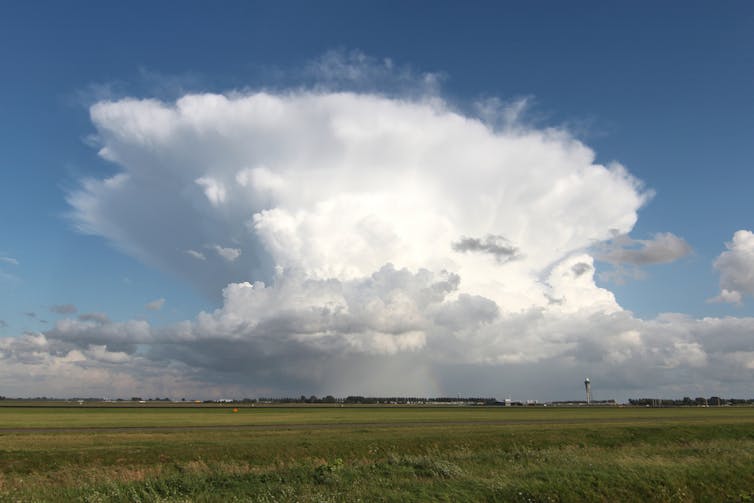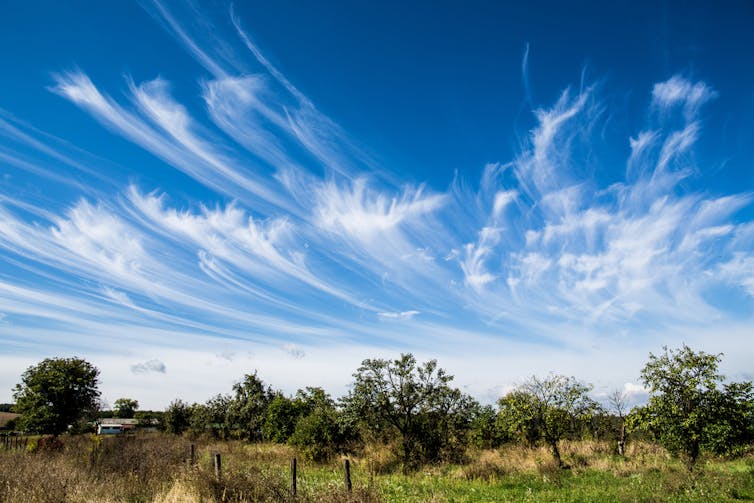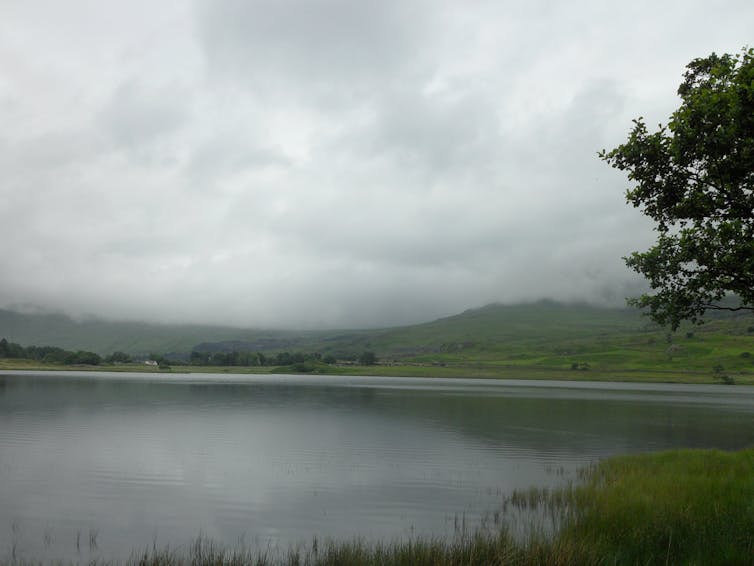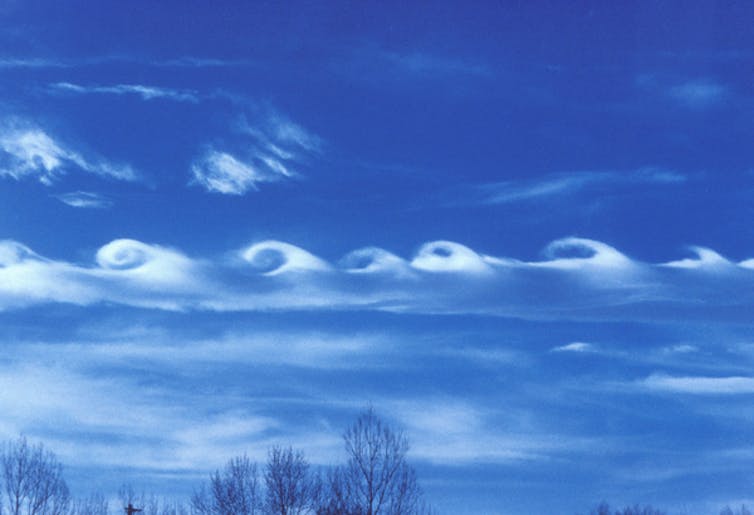Japaneseyour So Mean Winter Skies Are Clear Again
Modern atmospheric condition forecasts rely on circuitous computer simulators. These simulators use all the physics equations that depict the atmosphere, including the move of air, the sun's warmth, and the formation of clouds and pelting.
Incremental improvements in forecasts over time mean that modern five-twenty-four hour period weather condition forecasts are every bit skillful as iii-twenty-four hour period forecasts were 20 years agone.
But you don't need a supercomputer to predict how the weather above your head is likely to change over the next few hours – this has been known across cultures for millennia. By keeping an middle on the skies higher up you, and knowing a little about how clouds form, you lot can predict whether rain is on the way.
And a little understanding of the physics behind deject formation highlights the complication of the temper, and sheds some light on why predicting the atmospheric condition across a few days is such a challenging trouble.
So hither are six clouds to go on an centre out for, and how they can help you understand the conditions.
1) Cumulus

Clouds grade when air cools to the dew point, the temperature at which the air can no longer agree all its water vapour. At this temperature, h2o vapour condenses to form droplets of liquid water, which we observe as a deject. For this process to happen, we crave air to be forced to rise in the atmosphere, or for moist air to come into contact with a cold surface.
On a sunny day, the dominicus'south radiation heats the land, which in plow heats the air just in a higher place information technology. This warmed air rises by convection and forms Cumulus. These "fair weather" clouds look like cotton wool. If you await at a heaven filled with cumulus, you may notice they accept apartment bases, which all lie at the same level. At this superlative, air from ground level has cooled to the dew bespeak. Cumulus clouds do non more often than not rain – you're in for fine weather.
2) Cumulonimbus
While pocket-size Cumulus do non rain, if you notice Cumulus getting larger and extending higher into the temper, it's a sign that intense rain is on the manner. This is common in the summer, with morning Cumulus developing into deep Cumulonimbus (thunderstorm) clouds in the afternoon.

Well-nigh the basis, Cumulonimbus are well divers, just higher up they starting time to wait wispy at the edges. This transition indicates that the cloud is no longer made of h2o droplets, but water ice crystals. When gusts of wind accident h2o droplets exterior the cloud, they apace evaporate in the drier environment, giving h2o clouds a very sharp edge. On the other hand, ice crystals carried outside the deject practise not quickly evaporate, giving a wispy appearance.
Cumulonimbus are often flat-topped. Within the Cumulonimbus, warm air rises by convection. In doing so, it gradually cools until it is the same temperature as the surrounding atmosphere. At this level, the air is no longer buoyant and then cannot rise further. Instead it spreads out, forming a feature anvil shape.
iii) Cirrus

Cirrus form very high in the atmosphere. They are wispy, existence composed entirely of water ice crystals falling through the temper. If Cirrus are carried horizontally by winds moving at dissimilar speeds, they take a characteristic hooked shape. Just at very high altitudes or latitudes do Cirrus produce rain at ground level.
Simply if you find that Cirrus begins to cover more of the heaven, and gets lower and thicker, this is a expert indication that a warm front end is approaching. In a warm front, a warm and a cold air mass meet. The lighter warm air is forced to rising over the common cold air mass, leading to cloud germination. The lowering clouds indicate that the forepart is drawing near, giving a flow of rain in the next 12 hours.
iv) Stratus

Stratus is a depression continuous deject canvass covering the heaven. Stratus forms past gently rising air, or by a mild wind bringing moist air over a cold land or sea surface. Stratus deject is sparse, so while conditions may feel gloomy, rain is unlikely, and at virtually will be a light drizzle. Stratus is identical to fog, so if you've always been walking in the mountains on a foggy twenty-four hour period, yous've been walking in the clouds.
5) Lenticular
Our final two cloud types will non assistance y'all predict the coming weather, only they do give a glimpse of the extraordinarily complicated motions of the atmosphere. Polish, lens-shaped Lenticular clouds grade as air is blown up and over a mountain range.

In one case by the mount, the air sinks dorsum to its previous level. Equally information technology sinks, information technology warms and the deject evaporates. But information technology can overshoot, in which example the air mass bobs back up allowing another Lenticular cloud to class. This tin lead to a string of clouds, extending some way across the mountain range. The interaction of current of air with mountains and other surface features is one of the many details that take to be represented in estimator simulators to get accurate predictions of the weather.
6) Kelvin-Helmholtz
And lastly, my personal favourite. The Kelvin-Helmholtz cloud resembles a breaking ocean wave. When air masses at different heights move horizontally with different speeds, the situation becomes unstable. The boundary betwixt the air masses begins to ripple, eventually forming larger waves.

Kelvin-Helmholtz clouds are rare – the only time I spotted one was over Jutland, western Denmark – considering we can only meet this process taking place in the temper if the lower air mass contains a cloud. The cloud can then trace out the breaking waves, revealing the intricacy of the otherwise invisible motions above our heads.
Baca juga: 'Beast from the E' and freakishly warm Arctic temperatures are no coincidence
Source: https://theconversation.com/six-clouds-you-should-know-about-and-what-they-can-reveal-about-the-weather-93402
0 Response to "Japaneseyour So Mean Winter Skies Are Clear Again"
Enregistrer un commentaire